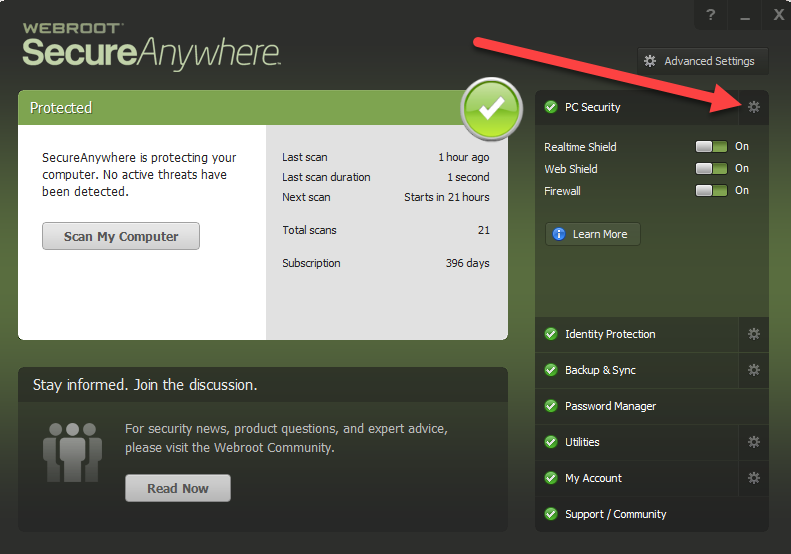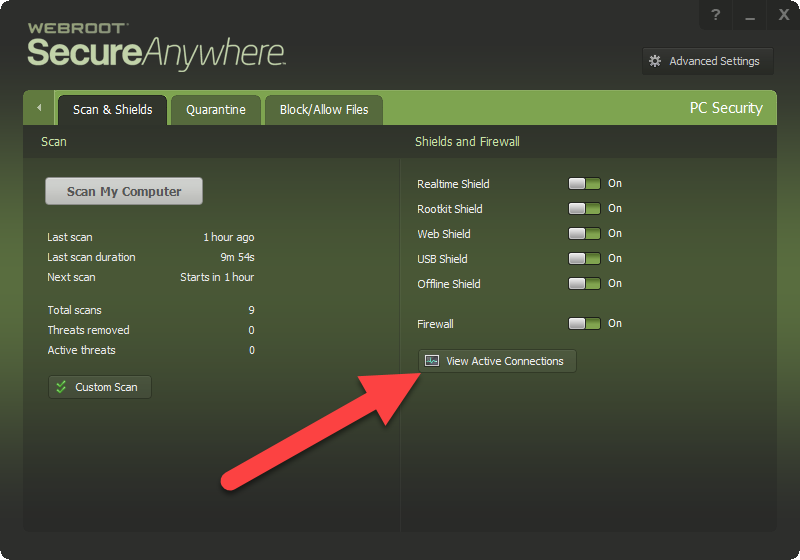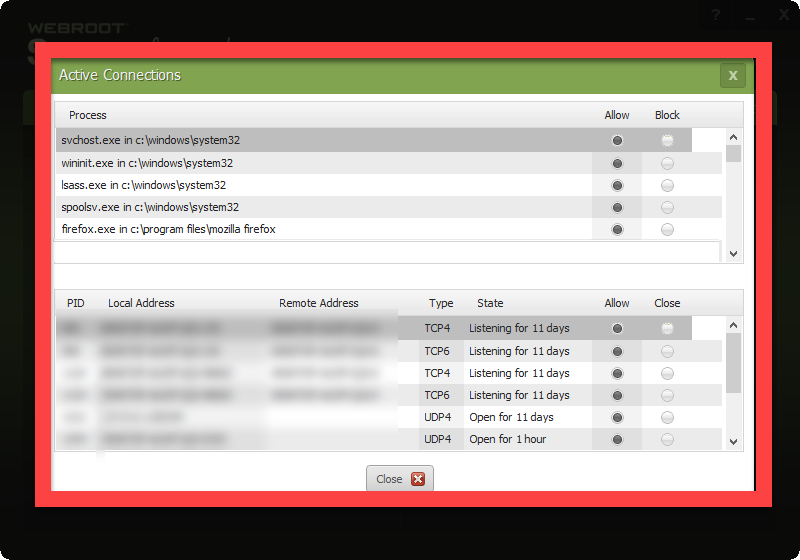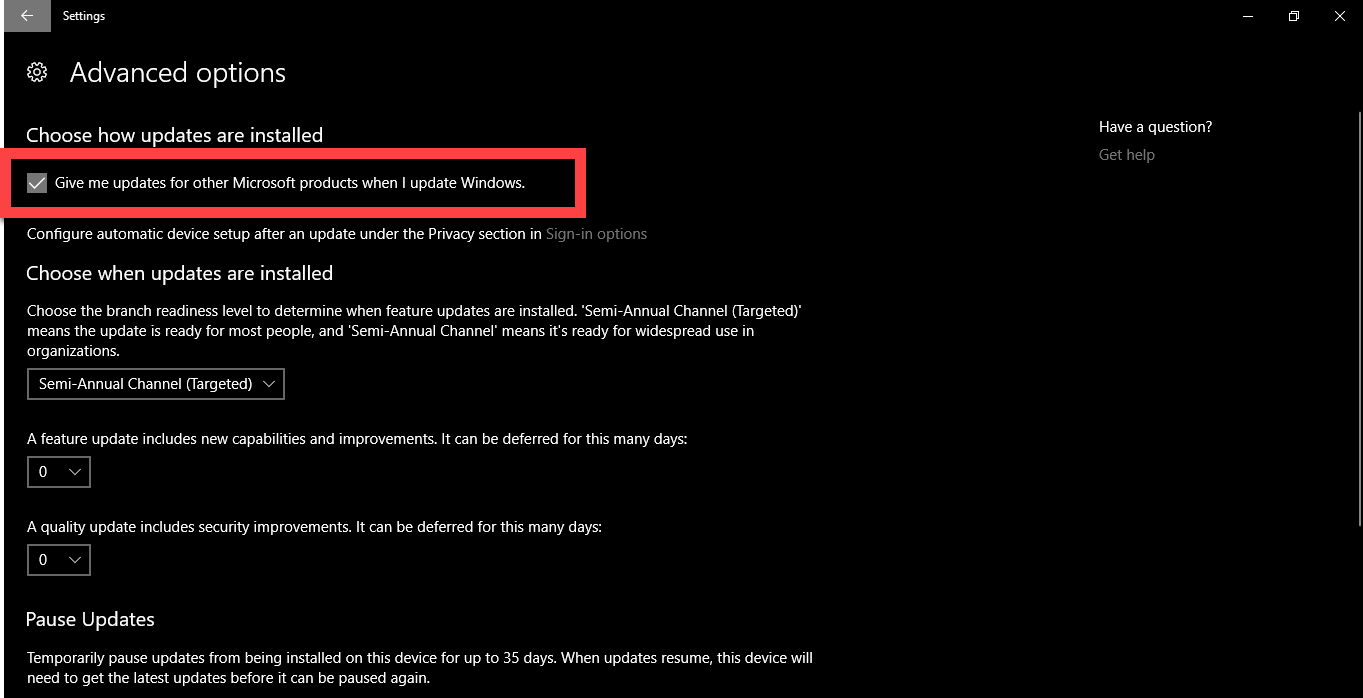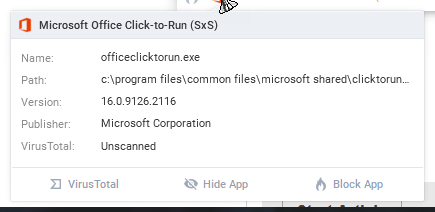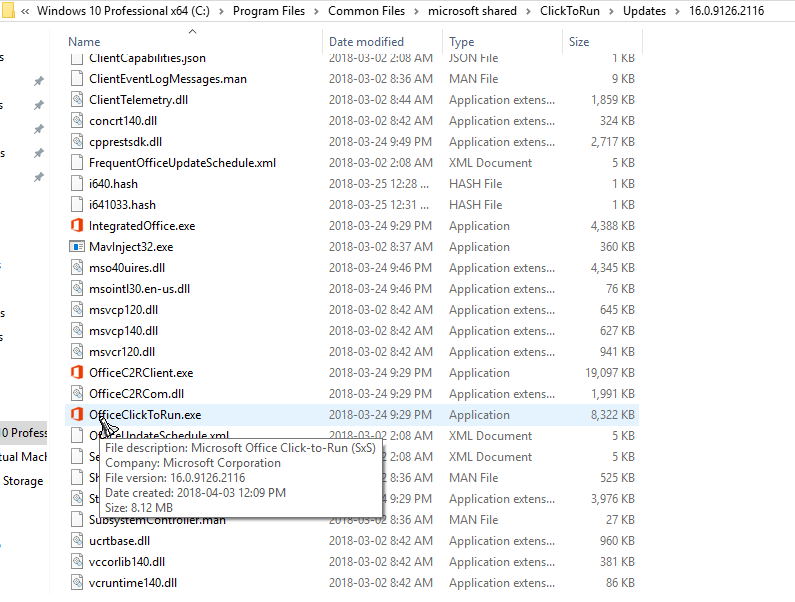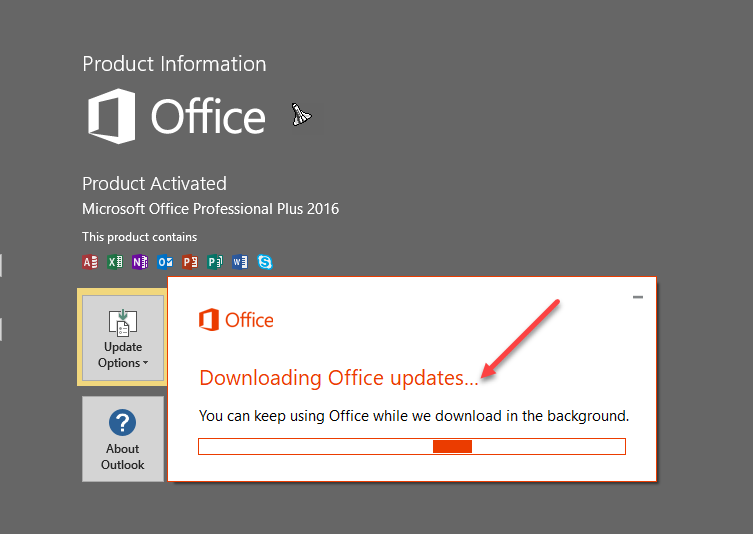When I booted my PC it asked for permission for this to run. Program FilesCommon Filesmicrosoft sharedClickToRunUpdates16.0.9126.2116 I wrote down that numbers but not the path and then it took me a long time to find this folder. Still not 100% sure if I should trust it but why is there no place that shows you what you have blocked or allowed. Well if there is such a place it is quite well hidden and it seems like it should have been super easy and something lots (most) people need to do at some point.
Page 1 / 1
Hello Freestone,
Welcome to the Webroot Community.
You can view/block/allow connections this way...
Open WSA, click on gear next to PC Security.
Then click the 'View Active Connections' button...
Here you can set to block/allow...
Hope this info helps. ;)
Let us know if you still have questions. :)
BD
Welcome to the Webroot Community.
You can view/block/allow connections this way...
Open WSA, click on gear next to PC Security.
Then click the 'View Active Connections' button...
Here you can set to block/allow...
Hope this info helps. ;)
Let us know if you still have questions. :)
BD
Perfect .... I stared and stared at the UI knowing that surely was an easy thing to do but never even saw the cogs. What is really odd is that today microsoft wanted to do this Program FilesCommon Filesmicrosoft sharedClickToRunUpdates16.0.9126.2116 and I click allow but that program is not in the block allow monitor list. When I book and click allow or block I have to click it many times and it alwasys dose seem that the link is not even active. I guess if you lie the time run out becuase the link block and allow neither work then it does not go in the list.
I'm not sure, but that file looks like an update for Microsoft Office. You should be able to update through Office or via Windows Updates (if you have updates set to update other Microsoft software).
Just a thought, perhaps other users who are more familiar with Microsoft Office will see this and offer their advice. ;)
I have Office installed on my home PC but I don't recall ever being asked by Webroot to allow files from Office. However, Office was installed before Webroot, so maybe that something to do with it?
Hope you get it figured out. ;)
BD
Just a thought, perhaps other users who are more familiar with Microsoft Office will see this and offer their advice. ;)
I have Office installed on my home PC but I don't recall ever being asked by Webroot to allow files from Office. However, Office was installed before Webroot, so maybe that something to do with it?
Hope you get it figured out. ;)
BD
Thank you,@ wrote:
@ I use Office 365 click to run this pop up sounds most likely to be a User Account Control popup from Windows rather than a Webroot one, I've never seen one from Webroot when updating Office 365 and there has been an update for Office recently.
Thanks again, :)
BD
Yes after some research I did figure out that it is an office update. Just confused about why I clicked Allow but it is no in the allow list ? Also as you say ....why is Webroot asking me for permission on this when it has never done so in the past. Guess these will just remain mistrying but thanks much for helping me figure out how to see the allow / block list.
"I use Office 365 click to run this pop up sounds most likely to be a User Account Control popup from Windows rather than a Webroot one, "
Well, I sure know the webroot modal window from a microsoft window. This was a Webroot modal window asking for permission but the permission links never seem to work when that happens.
Windows update and office update are two different things. Office update shows up in the office products. Most windows update you never see as they happen in background. For sure two different updates.
@ wrote:
Windows update and office update are two different things. Office update shows up in the office products. Most windows update you never see as they happen in background. For sure two different updates.
The updates are different, but for me, come from the same place, through Windows update. But I have the regular, one-time payment, Microsoft Office 2013, not the subscription Office 365. I also have my Windows updates set to update other Microsoft software, as well.
You're welcome, freestone. Glad I could help. ;)
@ wrote:
Guess these will just remain mistrying but thanks much for helping me figure out how to see the allow / block list.
BD
I have Office 2016 Pro Plus and I got the same notifcation from Glasswire so it's legit!
Here from the scan log:
[g] c:program filescommon filesmicrosoft sharedclicktorunupdates16.0.9126.2116officeclicktorun.exe [SHA256: 510359F585C909E5BB6D542C4CE6E5CEDFE6E235796DC343252FB21C4D06F1A5] [MD5: B9B3686F3ADCFC787CAE564259EBF15E] [Flags: 10011000.9758]
Here from the scan log:
[g] c:program filescommon filesmicrosoft sharedclicktorunupdates16.0.9126.2116officeclicktorun.exe [SHA256: 510359F585C909E5BB6D542C4CE6E5CEDFE6E235796DC343252FB21C4D06F1A5] [MD5: B9B3686F3ADCFC787CAE564259EBF15E] [Flags: 10011000.9758]
When you get these notices it is hard to know if you allow or not without 30 minutes of research.
More info here: https://support.office.com/en-us/article/what-s-new-in-office-365-95c8d81d-08ba-42c1-914f-bca4603e1426?ui=en-US&rs=en-US&ad=US@ wrote:
When you get these notices it is hard to know if you allow or not without 30 minutes of research.
Also just now as Office 2016 updates without the need for Windows Update unlike older versions of Office.
Reply
Login to the community
No account yet? Create an account
Enter your E-mail address. We'll send you an e-mail with instructions to reset your password.


